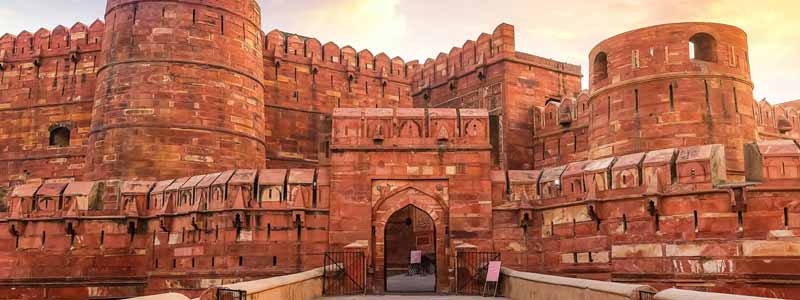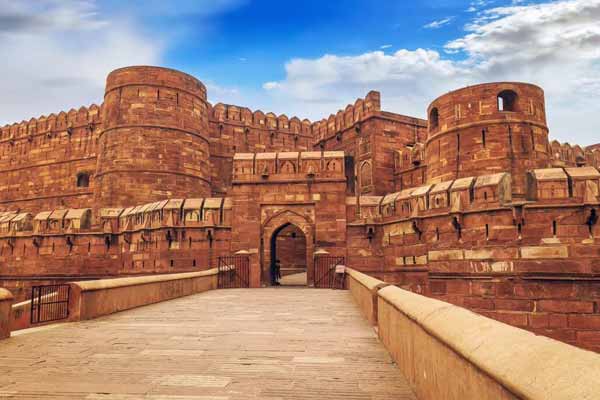Agra Fort and the Taj Mahal bear an exceptional and complementary testimony to a civilization which has disappeared, that of the Mogul Emperors. Agra’s history goes back more than 2,500 years, but it was not until the reign of the Mughals that Agra became more than a provincial city. Humayun, son of the founder of the Mogul Empire, was offered Jewellery and precious stones by the family of the Raja of Gwalior, one of them the famous Koh-i-Noor. The heyday of Agra came with the reign of Humayun’s son, Akbar the Great. During his reign, the main part of the Agra Fort was built.
The Red Fort of Agra is a powerful fortress founded in 1565 by the Emperor Akbar (1556-1605) on the right bank of the Yamuna; it is placed today on the north-west extremity of the Shah Jahan Gardens which surround the Taj Mahal and clearly form, with them, a monumental unity Agra Tour Packages.
This bastioned fortress, with walls of red sandstone rising above a moat and interrupted by graceful curves and lofty bastions, encompasses within its enclosure walls of 2.5 km, the imperial city of the Mogul rulers. Like the Delhi Fort, that of Agra is one of the most obvious symbols of the Mogul grandeur which asserted itself under Akbar, Jahangir and Shah Jahan.
The wall has two gates, the Delhi Gate and the Amar Singh Gate. The original and grandest entrance was through the Delhi Gate, which leads to the inner portal called the Hathi Pol or Elephant Gate. But now the entrance to the fort is only through the Amar Singh Gate.
Emperor Shah Jahan, who built the Taj Mahal, was imprisoned by his son Aurangzeb in Agra Fort, from which he had a view of the building erected for his deceased wife. Shah Jahan is said to have died in the Musamman Burj, a tower with a beautiful marble balcony Agra Monuments.

Agra Fort: History
Did you know that this fort in Agra was originally a fortress made of bricks, owned by the Chauhan Rajputs? Historians note that after the First Battle of Panipat in 1526, Ibrahim Lodhi had moved to Agra and was living in the fort. He was conquered and killed by Babur, the first Mughal ruler, who then captured the fort and built a Baori or a stepwell in it.
When the fort came under the control of Akbar, he decided to make it his capital. However, at that time, the fort was disintegrating and losing its glory and grandeur. So Akbar rebuilt the fort with red sandstone in its exteriors and bricks in its inner core. It took the diligent and laborious work of 1,444,000 builders for 8 long years to complete the construction of this fort in 1573.
Though the construction of the Agra Fort is attributed to Akbar, it was built into what we see today under the reign of Shah Jahan, the grandson of Akbar. He demolished many buildings inside the fort and rebuilt palaces and mosques using white marbles. Later, after the battle of Samogarh in 1658, the fort came under the control Aurangzeb, the son of Shah Jahan, who locked his father here for 8 years until his death.
After the death of Shah Jahan, the fort has been seized and plundered by many emperors and rulers. In 1803, during the Second Anglo-Maratha War, the Agra Fort was taken over by the British who handed its authority to the Government of India after independence.
Agra Fort Architecture
The opulent Agra Fort is made using red sandstone and marble and features the Mughal style of architecture. When viewed from above, the fort displays the shape of a semicircle and is enclosed by massive double battlemented walls made of red sandstone. These walls are about 2 km in perimeter and 70 feet in height. The fort has four gates namely Delhi Gate, Amar Singh Gate, Hathi Pol, and Ghaznin Gate. Of these, the Delhi Gate is the largest and was used as Akbar’s formal gate. Visitors are given access to the fort only through the Amar Singh Gate.
There are splendid rooms, magnificent mosques, and beautiful halls inside this fort. The main structures and monuments at the fort include public and private halls called Diwan-i-Am and Diwan-i-Khas, royal pavilions that house masjids, royal baths made using marble, a mirror palace or Sheesh Mahal, and courtrooms, among others. It is believed that the fort once had over 5000 structures and monuments inside it. However, only a dozen of these stood the test of time.
Best Time to Visit Agra Fort
Agra Fort is at prime beauty throughout the year. The weather has very little to do with the beauty of the place. However, the entire fort covers 380,000 square meter. This is quite a large area to explore. April to June would have the hottest and humid temperature. This can cause dehydration or fatigue while exploring. Moderate rainfall is common during July to September. Not everyone will be comfortable in exploring the place in rain.
Thus, it is best to visit the place from October to March. This is the winter season of the region and the climate will be pleasing for exploring the fort. Moreover, the sky will be clear throughout the day and you would be able to spot the view of Taj Mahal from Agra Fort with ease.
How to Reach Agra Fort
Nearest place of transport is Agra Fort Railway Station which is only 1 Kilometer away, most of the trains connecting Rajasthan and Gujarat arrives and departs from here. The distance from Agra Fort to Taj Mahal is only two and half kilometers, can be covered easily in 15 minutes. Rickshaws and battery operated vehicles are easily available here.
